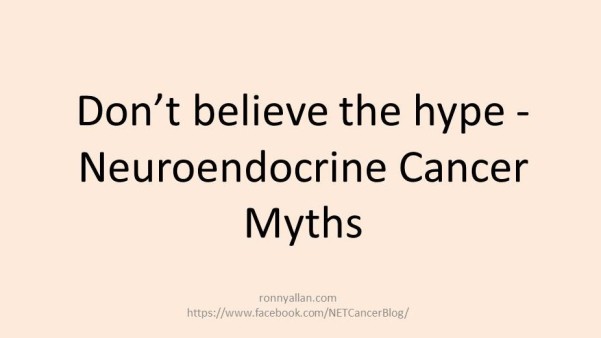
There’s a lot of inaccurate information out there …….
Not true. By any scientific definition, the word ‘tumour’ means ‘an abnormal mass of tissue that results when cells divide more than they should or do not die when they should. Tumours may be benign (not cancerous), or malignant (cancerous)’. However, The World Health Organisation (WHO) 2010 classification is based on the concept that all NETs have malignant potential, and has therefore abandoned the division into benign and malignant NETs and tumours of uncertain malignant potential. Read more here.
Not true. By any definition of the word terminal in a medical diagnostic context, most NET patients have a good prognostic outlook, even those with metastatic incurable disease. Read more here.
Not true. Carcinoid is a very old term and was phased out 17 years ago. Carcinoid is not mentioned in the latest WHO Classification schemes for Neuroendocrine Neoplasms (a term covering Neuroendocrine Tumours and Carcinoma). “Carcinoid Neuroendocrine”, “Neuroendocrine Carcinoid”, “Carcinoid and Neuroendocrine”, “Neuroendocrine and Carcinoid” are all contextually incorrect and misleading terms. Read more here and here.
Not true. Firstly, many NET cancers are non-functional; and secondly, carcinoid syndrome is only one of a number of “NET Syndromes” associated with the various types of NET. An example from ENETS indicates that Small Intestinal NETs (SiNETs) have a 30% prevalence of ‘Carcinoid Syndrome’ in those with metastatic disease. However, the issue is further confused by those who use the word ‘Carcinoid‘ to incorrectly refer to all Neuroendocrine Tumours. Read more here.
Not true. As a collective grouping of cancers, this is no longer accurate. Read more here.
Not true. Steve Jobs had a Neuroendocrine Tumour of the Pancreas. Ditto for a few other famous names. Read more here.
Not true. For some cancers or some sub-types of cancers, chemotherapy is not particularly effective, e.g. some types of Neuroendocrine Cancer (NETs). In general, well differentiated NETs do not show a high degree of sensitivity to chemotherapy. However, many of the treatments for NET Cancer are somewhat harsh, have long-term consequences, and have no visible effects. NET patients are often said to “look well” but that doesn’t mean they are not struggling behind the scenes or under the surface. Read more here.
Not true. It could be a side effect of your treatment. Check out this post.
Not true. Simply, no cancer is good. Some are statistically worse than others in prognostic terms, that’s true. However, no one cancer is better to get than any other -they’re all bad. Read more here.
Not true. Many NET Patients are correctly diagnosed early on in their investigation and in a reasonable time. This myth is perpetuated because of two things: firstly, on forums, the ratio of long-term misdiagnosis is high creating a false perception; and secondly, the method of capturing patient surveys is not extensive enough – again creating a false perception. In fact, the latest and largest database analysis from US indicates earlier diagnosis is improving. Read more here.
Not true. Somatostatin Analogues (e.g. Octreotide and Lanreotide) are not chemotherapy, they are hormone inhibiting drugs (or hormone therapy). For the record, Everolimus (Afinitor) and Sunitinib (Sutent) are not chemotherapy either. Read more here.
Not true. This is a common misunderstanding within the community. They both had Pseudomyxoma Peritonei (PMP). Read more about PMP here.
Not true. Many patients live a very long time and lead fairly normal lives with the right treatment and support. It’s difficult but I try not to use ‘I can’t’ too much. Read more here.
Thanks for reading
Ronny
Hey Guys, I’m also active on Facebook. Like my page for even more news.
My Diagnosis and Treatment History
Sign up for my twitter newsletter
Check out my Podcast (click and press play)
Remember ….. in the war on Neuroendocrine Cancer, let’s not forget to win the battle for better quality of life!
Whatever cancer throws your way, we’re right there with you.
We’re here to provide physical, financial and emotional support.
© Macmillan Cancer Support 2024 © Macmillan Cancer Support, registered charity in England and Wales (261017), Scotland (SC039907) and the Isle of Man (604). Also operating in Northern Ireland. A company limited by guarantee, registered in England and Wales company number 2400969. Isle of Man company number 4694F. Registered office: 89 Albert Embankment, London SE1 7UQ. VAT no: 668265007